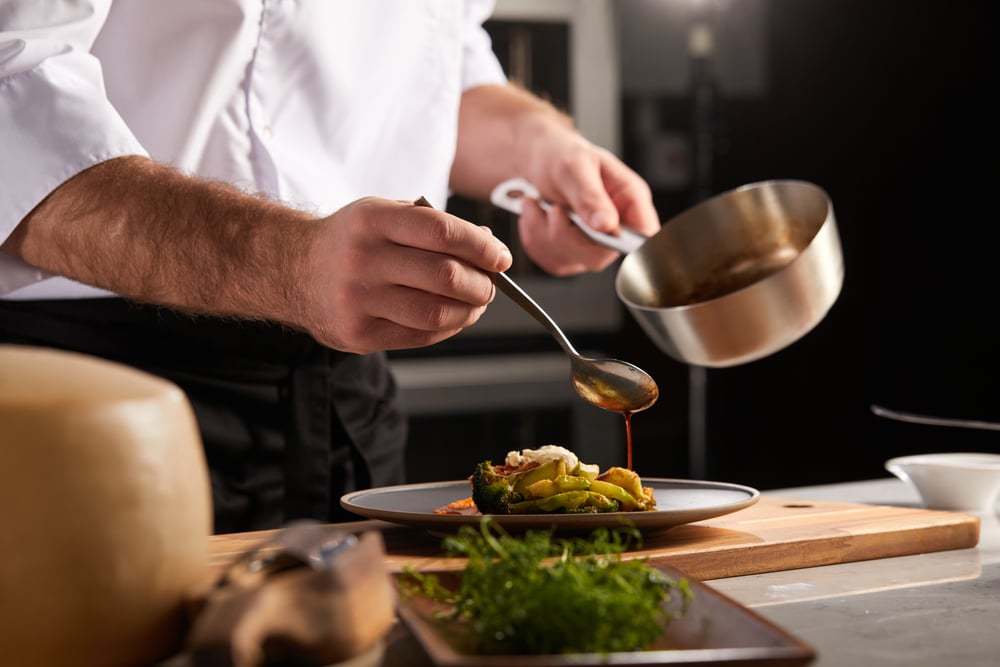At the peak of social media and food bloggers, food presentation and plating have never been more important. Photos and videos of one single dish and then shared by multiple people online, tempting more customers to dine at your restaurant. The value of sight cannot be overlooked in the overall dining experience.
The plating process is a culinary art but it's not only about how visually appealing your food is either. Excellent food plating techniques can evoke the appetite and feelings of anticipation and excitement. We engage all our senses while dining, not solely relying on taste. When a diner chooses to eat out, they want all their senses invigorated.
Whether you own a casual home-style restaurant or a fine dining venue, our food presentation tips can elevate your culinary expertise.
Why Food Presentation Matters
In a study by the National Library of Medicine, it was concluded that "our subjective sense of taste is significantly influenced by our visual perception". In other words, when food is visually appealing, it can stimulate our appetite and taste buds significantly. This is why we have the common phrase "we eat with our eyes first".
The multiple benefits of food plating and presentation go beyond visual appeal:
- Highlights your high-quality food - Exceptional ingredients and cooking expertise deserve a high-quality finished plate.
- Worth a higher price tag - Customers are willing to spend more when they see the care and effort involved.
- Enhanced flavour perception - Dishes with aesthetic appeal can increase the perception of flavours.
- Competitive edge - Food plating is an art form in which the chefs can express themselves. Your restaurant can stand out from the competition with a unique style.
- Brand image - High-quality food plating demonstrates your brand's commitment to quality, professionalism and attention to detail.
- Improved operations - Consistency and attention to detail are some of the ways you can improve restaurant operations. Setting a benchmark with your staff members enhances customer service.
Key Considerations for Food Plating Techniques
Great food presentation relies on quality ingredients and excellent cooking skills. Roast, fry or braise your food to perfection to stand out on the plate and create textures. Vary your dishes with contrasting colours, different sauces and edible garnishes to elevate tastes and visual appeal.
Equip your chefs with the best tools and plate styles to match your cuisine.
Deciding Your Plate Style
Plating food in a stunning presentation will depend on your plate size and style. It should represent your branding and cuisine to boost your dining experience. With varying sizes and colours, the right plate size should be in proportion to your portion size.
Consider the following plates:
- Classic round white plates - Usually used for fine dining restaurants, white plates offer a clean and sophisticated presentation.
- Square plates - A contemporary option for a simple presentation. A square plate can highlight your food plating through different shapes.
- Platters - For a home-style sharing menu, food plating can scale for large plates or platters. Don't underestimate the importance of food presentation on a larger scale.
- Boards or slates - Food presentation can still be a priority for more casual or grill restaurants by using boards or slates for food plating.
Kitchen Tools You May Need
To create dishes with unique food presentation designs, you may need some extra tools to be precise when plating:
- Precision tongs
- Squeeze bottles for drizzling
- Plating brushes to sauce
- Food tweezers for delicate items
- Plating spoons for decorative designs
11 Food Presentation and Plating Techniques
- Use textures
- Play with colours
- Follow an order
- Make a focal point
- Create height
- Serve small portions
- Fluff up vegetables
- Don't forget your sauces
- Wipe the edges
- Garnish for a finishing touch
- Add service flare
1. Use textures
A combination of smooth and soft or hard and crispy textures creates depth in your food presentation. It's important to balance every element of your plate, including the texture. Create contrasting textures through:
- Puree sauce for a soft base
- Seared protein with a crisp finish
- Crunchy nuts
- Shiny glaze
- Foam sauce
- Scorched sugar
Once you have prepped the perfect elements with a burst of flavour, be playful in the final presentation.
2. Play with colours
Vibrant and contrasting colours naturally attract interest in any situation. With food plating, colours can make dishes more visually appealing and stimulate the appetite. Bold combined with soft colours can also influence the diner's perception of flavour. A colourful food presentation on a table will set a bright mood and anticipation.
3. Try free-form plating
Free-form plating is the technique of treating the plate like an artistic canvas. The chefs can get creative with splashes of food and colour, smearing, drizzling and drawing for a food presentation masterpiece. By being loose with your free-form plating, every dish will be unique and exciting.
4. Make a focal point
Many food presentation tips from chefs advise to start in the middle of the plate to create a main focal point. Other elements will then support the main ingredient around the plate. It's also important to leave empty space to avoid overcrowding and overwhelming your diner.
5. Create height
Ever heard the phrase "people eat with their eyes"? Creating height gives the illusion of more food and elevates the perception of great value. You can create height with your food placement by:
- Stacking - Placing vegetables on top of each other for an interesting mound.
- Layering texture - Rather than placing food into individual sectors on the plate, layer on top of each other. For example, layer fish on top of mashed potatoes to create a peak.
- Spiralling - Spiral vegetables or twist pasta into a bouncy mound.
- Vertical placement - Plating your main ingredient at an odd angle can add a sharp high point to your dish.
6. Serve small portions
As a general rule, leaving empty space on the plate will allow your food to stand out. It frames the dish and encourages the diner to focus on the characteristics of the plate. By serving smaller portions, you can be more creative with the balanced placement.
7. Fluff up your vegetables
Fluffing up vegetables can create more texture and appeal on the plate. The fluff process involves gently tossing or separating the vegetable pieces to prevent clumping and to create a more airy and appealing texture. It can also help them to absorb the glaze or sauce you drizzle on, which will enhance the flavour.
8. Don't forget your sauces
Sauces are delicious but can also make your food plating more exciting. Here are some sauce food presentation tips:
- Dollop and Swoop - Place a spoonful of sauce on the plate and use the back of the spoon to drag the sauce to the other side of the plate, creating a swooping effect.
- Squeeze Bottle - Use a squeeze bottle to create artistic designs or precise lines with the sauce. This technique is suitable for thick, smooth sauces that will hold their shape.
- Brushing - Dip a clean brush, such as a pastry brush, into the sauce and brush it across the plate to create elegant designs or patterns.
- Pooling - For larger servings of sauce, such as a red wine pan sauce or crème anglaise, create a pool of sauce on the plate to complement the dish.
- Splatter Technique - Use a squeeze bottle to create splatter designs by applying pressure at an angle to the plate, creating various dot sizes for contrast.
- Zig Zag Technique - Use a squeeze bottle to create zigzag patterns with the sauce, adding visual interest to the plate.
9. Wipe the edges
After taking such care in your food plating techniques, it pays to clean the negative space on the place. This is especially important for fine dining restaurants using white plates. A clean framed plate adds sophistication and quality to your dish.
10. Garnish for a finishing touch
Herbs, edible flowers and nuts can be the "topping on the cake" you need. Garnishes add an extra special quality and texture and enhance the perception of depth and flavour.
11. Add service flare
How you serve your food to your diner is as important as your food plating. This is exceptionally important in the age of social media where diners are looking to share their dining experience online. Consider asking your waiter to finish the final element of food plating at the table in front of the customer. Some ideas include:
- Flambé - The flames from flambéing can create a sense of excitement and anticipation.
- Caramelising - Use a burner to caramelise your sauce or glaze in front of the diner.
- Creative garnishing - Add your herbs or toppings at the table to show the effort put into your dishes.
- Smoking - Use a smoker to add a dramatic presentation and extra flavour.
Focusing on the customer’s experience within the food plating process is what makes a restaurant 5-star quality.
Grant Chefs More Time For Food Presentation
Careful food presentation takes a lot of time and effort. It requires precision, focus and a steady hand. The last thing you want is a stressful restaurant kitchen environment causing your chefs to rush their plating.
Support your chefs by investing in technology for real-time order management. ResDiary’s restaurant reservation system order feature allows instantaneous communication between customer ordering and kitchen workstations.
With over 50 integrations including food inventory, kitchen processes can be streamlined for accuracy and speed. Restaurant technology saves time for your chefs and servers so they can focus on food presentation and customer service.



